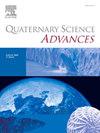20Large mammal faunas and ecosystem dynamics during the late Middle to early Late Pleistocene at Grotta Romanelli (southern Italy)
IF 2.2
Q2 GEOGRAPHY, PHYSICAL
引用次数: 0
Abstract
Since the beginning of the XIX century, Grotta Romanelli gained recognition in European stratigraphy as an important site for the Late Pleistocene, due to the attribution of its basal sediments to the Last Interglacial (MIS 5e). Its abundant archaeological and paleontological findings made the cave a key reference point for the study of human evolution and faunal dynamics in the larger Mediterranean area over approximately the last 130,000 years. After a century, a new chronostratigraphic reassessment of Grotta Romanelli revised the timeframe of its lower levels, predating them to the late Middle Pleistocene.
In this study, we re-evaluate selected historical museum collections from the so-called “lower complex” of Grotta Romanelli and examine the new fossils excavated between 2015 and 2022. We identify three main mammal assemblages associated with three different interglacial periods spanning the last 350,000 years. Our findings offer new insights into terrestrial ecosystems in Mediterranean Europe from the late Middle Pleistocene to early Late Pleistocene. Additionally, they provide valuable information to the biochronological framework of the European large mammal faunas.
20 Grotta Romanelli(意大利南部)中更新世晚期至晚更新世早期的大型哺乳动物群和生态系统动力学
自十九世纪初以来,罗曼内利石窟在欧洲地层学中被认为是晚更新世的一个重要遗址,因为其基底沉积物被归属于末次间冰期(MIS 5e)。丰富的考古和古生物学发现使该洞穴成为研究大约 13 万年以来大地中海地区人类进化和动物动态的重要参照点。一个世纪后,对罗曼内利石窟进行了新的年代地层学重新评估,修订了其下层的时间框架,将其提前到中更新世晚期。在这项研究中,我们重新评估了罗曼内利石窟所谓的 "下层复合体 "的部分历史博物馆藏品,并考察了 2015 年至 2022 年期间发掘的新化石。我们确定了与过去 35 万年三个不同冰期相关的三种主要哺乳动物组合。我们的发现为了解地中海欧洲从中新世晚期到晚更新世早期的陆地生态系统提供了新的视角。此外,它们还为欧洲大型哺乳动物群的生物年代学框架提供了有价值的信息。
本文章由计算机程序翻译,如有差异,请以英文原文为准。
求助全文
约1分钟内获得全文
求助全文
来源期刊

Quaternary Science Advances
Earth and Planetary Sciences-Earth-Surface Processes
CiteScore
4.00
自引率
13.30%
发文量
16
审稿时长
61 days
 求助内容:
求助内容: 应助结果提醒方式:
应助结果提醒方式:


